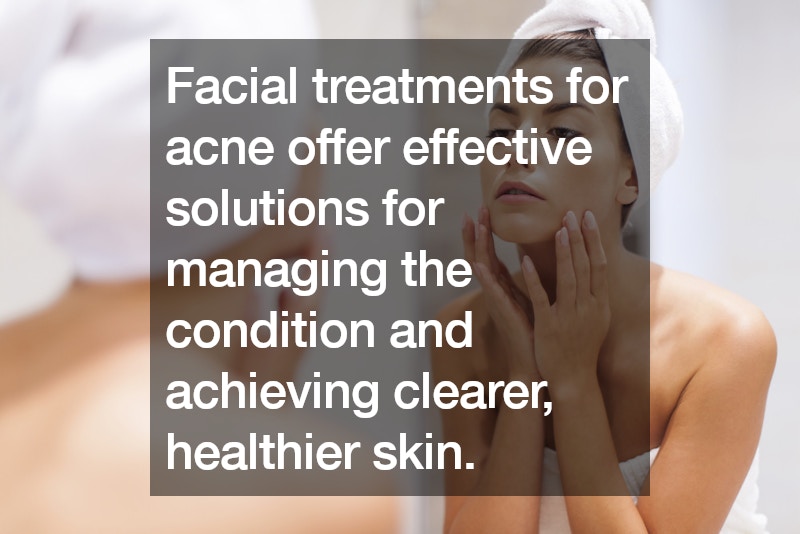Acne is a common skin condition that affects millions of people worldwide, characterized by the presence of pimples, blackheads, and other types of blemishes. While acne can be challenging to manage, especially severe or persistent cases, various facial treatments offer effective solutions for improving skin health and reducing acne breakouts.
The Importance of Facial Treatments for Acne
Facial treatments for acne play a crucial role in managing the condition by targeting specific concerns such as inflammation, excess oil production, and clogged pores. These treatments are designed to cleanse, exfoliate, hydrate, and rejuvenate the skin, promoting a clearer complexion and reducing the risk of future breakouts.
Skin Assessment and Cleansing
Before undergoing any facial treatment for acne, it’s essential to undergo a thorough skin assessment to determine the underlying causes of the condition and identify specific areas of concern. A professional skincare practitioner will examine the skin, looking for signs of inflammation, surface dryness, oiliness, and the presence of acne lesions such as blackheads and pustules.
One of the initial steps in facial treatments for acne is cleansing the skin using gentle yet effective cleansers. These cleansers are formulated to remove dirt, oil, and impurities without stripping the skin of its natural moisture barrier. Ingredients like cucumber and aloe vera help soothe and hydrate the skin, preparing it for further treatment.
Hydration and Treatment Products
Hydration is crucial for maintaining healthy skin, especially for individuals with acne-prone skin. Facial treatments often involve the use of hydrating serums and gels to replenish moisture levels and restore balance to the skin. Eye gels are recommended to hydrate the delicate eye area and minimize the appearance of fine lines and wrinkles.
Treatment products containing ingredients like retinol, salicylic acid, and benzoyl peroxide are commonly used in facial treatments for acne. These ingredients help exfoliate the skin, unclog pores, reduce inflammation, and promote cell turnover, resulting in smoother, clearer skin over time.
Extractions and Skin Healing
Extractions are a vital component of facial treatments for acne, especially for removing blackheads, whiteheads, and other impurities that contribute to breakouts. Skilled practitioners perform extractions carefully to avoid spreading infection and causing scarring. Healing gels containing ingredients like aloe vera help soothe the skin after extractions and promote faster healing.
Specialized Masks and Final Treatment
Specialized masks, such as purifying masks infused with lightening agents, are often used to address specific concerns like scarring and pigmentation. These masks are left on the skin for a designated period to allow for optimal absorption of active ingredients.
Final treatments, such as retinol-based night gel complexes, are applied to the skin to promote cell turnover and reduce the appearance of scarring over time. These treatments help improve skin texture and tone, resulting in a smoother, more even complexion.
Acne is a multifactorial skin condition influenced by various internal and external factors. Understanding the underlying causes of acne is essential for effective treatment and management.
One primary cause of acne is excess oil production by the sebaceous glands. These glands produce an oily substance called sebum, which can clog pores when overproduced, leading to the formation of comedones (blackheads and whiteheads).
Another contributing factor is the buildup of dead skin cells on the skin’s surface. When these cells mix with excess sebum, they can form a plug in the hair follicles, creating an environment conducive to bacterial growth.
Bacterial infection plays a significant role in the development of inflammatory acne. Propionibacterium acnes, a type of bacteria found on the skin, can proliferate in clogged pores, causing inflammation, redness, and swelling.
Hormonal fluctuations, particularly during puberty, menstruation, pregnancy, and times of stress, can also trigger or exacerbate acne breakouts. Hormonal changes influence oil production and skin cell turnover, increasing the likelihood of pore blockage and bacterial infection.
Other factors such as genetics, diet, medications, and environmental factors may also contribute to the development of acne. By addressing these underlying causes through targeted skincare and lifestyle modifications, individuals can effectively manage acne and achieve clearer, healthier skin.
Conclusion
Facial treatments for acne offer effective solutions for managing the condition and achieving clearer, healthier skin. By addressing specific concerns such as inflammation, excess oil production, and clogged pores, these treatments help reduce acne breakouts and improve overall skin health. By addressing factors such as excess oil production, buildup of dead skin cells, bacterial infection, hormonal fluctuations, and other contributing elements, individuals can better manage acne and achieve clearer, healthier skin through appropriate facial treatments. With proper skincare guidance and professional expertise, individuals can enjoy long-term results and a renewed sense of confidence.
.







